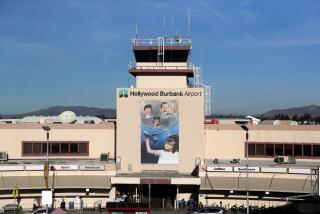‘Human Error’ Gets Blame for Terminal Cost Overrun
- Share via
The $19-million cost overrun on the new terminal at John Wayne Airport was blamed Wednesday on gross miscalculations, not bid inflation by contractors.
The airport staff said it had accepted a consultant’s report concluding that “human errors” in quantifying and pricing various items explain $15 million of the $19-million difference between the expected $40.8-million cost of the terminal and a low bid that came in at $59.7 million.
The $19-million difference set off a controversy over whether the entire $310-million airport expansion project was being mismanaged and led to fines against the architect and a major cost reduction effort involving a new roof design, a cheaper window system, and less use of marble and other materials. Now the terminal is expected to cost about $48 million, which the county can still afford, according to a recent report by the Orange County Grand Jury.
The latest report from consultant Robert K. Cosselman echoes similar findings he made several months ago. After that report, county officials asked for additional details.
Discrepancy Unexplained
Those were released Wednesday, although Cosselman’s report still does not explain $4 million of the discrepancy between the terminal’s cost, as estimated by consultant Lee Saylor Inc. for airport architect Leason Pomeroy, and the low bid from prime contractor Taylor Woodrow Construction California Ltd.
Nevertheless, Cosselman wrote in his latest report to airport officials, “we feel that with further examination . . . most of the remaining differences could also be uncovered.”
Pomeroy and Saylor could not be reached for comment Wednesday. However, they disputed similar findings contained in an earlier report by a construction management firm hired by Cosselman.
“We want to look forward now and not look back, trying to fix blame,” airport spokeswoman Kathie Rutherford said Wednesday.
Some facilities, such as new parking garages and taxiways, have come in under budget, with the savings applied to the cost of the new terminal.
Scheduled to open April 1, 1990, the new terminal is expected to serve up to 8.4 million passengers annually, nearly twice the current passenger volume in the existing, 22-year-old facility.
Cosselman’s latest conclusions were based on a study by a firm he subcontracted with, Santa Ana-based O’Connor Construction Management Inc. The Times disclosed results of O’Connor’s study last October, which came as a surprise to airport officials who admitted that they had forgotten that they had hired someone to conduct an investigation.
In November, cost estimator Saylor vehemently disputed O’Connor’s conclusions and charged that the county was being overcharged for the terminal. He said the bids were based either on prices for materials that had been deliberately inflated or on an attempt by the bidders to cover the expected cost of fines that could be levied by the county for missing construction deadlines.
Number of Bidders
Saylor also alleged that there were too few bidders on the project--five instead of the recommended minimum of six--and that he had been given incomplete design drawings.
Airport officials were also worried that Cosselman and O’Connor had not adequately supported their initial conclusions. The Times also learned that a former Taylor Woodrow employee had supplied some of the price information used in O’Connor’s report and had helped prepare it. And the O’Connor report failed to explain whether the material prices used by Taylor Woodrow and other contractors in preparing bids accurately reflected prices available to builders of similar projects elsewhere.
Also, airport officials wanted to know more about how the project’s 20-month schedule affected the bids and whether or not the prospect of fines for late completion affected the bidding.
If Saylor’s prices for various items were accurate, some officials reasoned, then an obvious conclusion would be that bids, which were relatively close, were all inflated--something airport project managers said could not have gone undetected.
Airport officials asked Cosselman to provide more information, resulting in his latest report.
Among the findings:
- “A cost of $60 million is reasonable for the facility.”
- The quick construction schedule “did not have an overwhelming impact on the bids. . . . If a contractor did add an amount for schedule and liquidated damages (potential fines), we would anticipate it to be a very small percentage of the total cost of the facility.”
- “There were five competitive bids received for the terminal with the four lowest bids being within 3.5% of each other. This is an adequate number of bidders for this facility.”
- “The quality of the design documents was good and did not appear to contribute to the cost variance.”
- “The structural steel was the single largest cost in the estimate at approximately $12.5 million, and the single largest cause of a variance at approximately $4.5 million, or 55% higher” than estimated by Saylor.
- Saylor underestimated by 65% the cost of the vaulted roof design and glazing system, the second-biggest item affecting prime contractors’ bids on the terminal project.
Airport expansion program supervisor Alan Murphy said recently that he was satisfied that Cosselman’s findings are correct and that no further investigation is necessary.
Partly influencing that view, Assistant Airport Manager Jan Mittermier said, was Pomeroy’s decision last year to pay penalties totaling $775,000 for problems associated with the cost overruns.
“We figured whatever dispute remains is between Pomeroy and the people he hired to work out among themselves,” Mittermier said.
More to Read
Sign up for Essential California
The most important California stories and recommendations in your inbox every morning.
You may occasionally receive promotional content from the Los Angeles Times.













